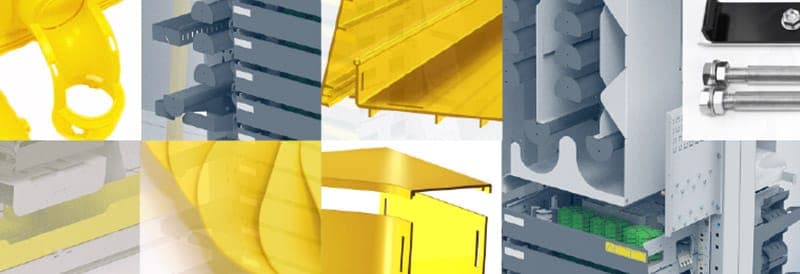Build resilience into your Network
News - July 22, 2016

Network downtime has the potential to cost organisations thousands or even millions of dollars. A vast number of these causes are often attributed to poorly installed or managed cabling infrastructure. Delicate optical fibre patch cords transmit large volumes of critical data and need to be adequately protected and segregated from heavy electrical and copper data cabling. Optic fibre patch cords, which can range in diameter from 1.6mm, 2mm and up to 3mm for simplex patch cords, can be quite delicate and need to properly managed and routed in order to maintain and ensure network reliability.
What are some of the challenges faced when managing an optical fibre network?
- Mixed cabling types
At times, various cabling infrastructure types including optical fibre patch cords, copper data cable and HV electrical cable are all routed side by side, along the same pathway, with no segregation. This provides a challenge for network operators as locating, re-routing and accessing optic fibre patch cords can be difficult. As the network expands and new links are added, cable management can potentially become a nightmare!
- The use of a wire basket tray
By routing optic fibre patch cords on a wire basket tray, you are exposing them to potential damage. Even if routed separately on a wire basket tray, pressure points (micro bends) can develop in the cable due to the gaps in the wire basket, leading to signal degradation or loss. If heavy copper cables are placed on top of the optic fibre cables, the pressure point and signal loss will be increased. This can even lead to the internal glass fibres breaking under the pressure. Therefore, wire basket tray has not been developed specifically for optic fibre patch cords and does not provide any bend radius protection or storage options. Furthermore, Technicians working in the facility superstructure or installing other cables, can potentially drop heavy tools, lean on, or damage the patch cords in other ways.
- Using ruggedised optical fibre patch cords on wire basket tray
To avoid installing an optical fibre ducting raceway and understanding the risks associated with routing delicate optical fibre patch cords on a wire basket tray, some network operators opt for the assumed safer/better option of using ruggedised patch cords. Even though the ruggedised cable is much sturdier than a standard patch cable, a number of other challenges are presented:
- Ruggedised cable has a greater outside diameter (OD) when compared to standard patch cord cables. Therefore, less space is available in pathways
- Ruggedized cable is not as flexible and cannot be as easily routed
- Breakouts on ruggedized cable need to be properly managed and pre-specified
- Ruggedized cable can be harder to manage around patching fields and in subracks, providing additional challenges
- High core count ruggedized cables (i.e >12F) can be extremely inflexible. In addition, when the time arrives for Moves, Add’s and Changes (MAC’s), the whole link may need to be replaced or re-configured. Individual patch cords provide more flexibility for MAC’s
- Ruggedized patch cords are higher in cost than standard patch cords
What benefits does an optical fibre ducting raceway provide?
- Provides a dedicated cabling pathway for optic fibre patch cords, ensuring easy identification, traceability and management
- Protects from micro bending when feeding cords into equipment racks
- Segregates delicate optic fibre patch cords from heavy copper data or HV electrical cable
- Protects optic fibre patch cords from external damage or unauthorized access
- Provides protection against compression, and ensures minimum bend radius, generally specified as 30mm (1.25″) is not be compromised
- Allows excess patch cord lengths to be safely stored
- Is easy to install and configure
- Provides an effective long term solution
- Helps protect your investment by reducing risks of network downtime caused by cable or connectivity failure
Therefore, a dedicated optical fibre raceway provides the most effective solution as it has been purposely designed with optical fibre properties in mind. An optical fibre ducting raceway safely routes, protects, stores and segregates fibre optic patch cords from external elements and other cabling types as well as providing bend radius protection.
